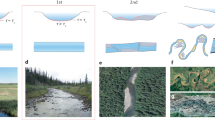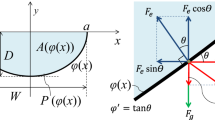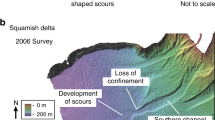Abstract
THERE are two simple models which describe the equilibrium state of a channel cross-section with constant conditions, one static, the other dynamic. In the first case equilibrium is said to hold when all grains on the bed are just at the threshold of movement1. Because movement is produced by a combination of fluid drag and the downslope gravity component and because the fluid drag is greatest in the centre of the channel, the channel slopes can increase up the sides to compensate for the decrease in drag. The resulting profile is roughly a parabola1 and is very similar to many natural channel forms. This static model is particularly relevant to the design of some canals where discharges are fairly constant and the bed material is normally immobile. Natural rivers transport sediment, however, and the mean channel form develops at high stages when nearly all the bed material is in intermittent motion. When sediment is transported as bed load it must be continually tending to creep downslope into the centre of the channel under the influence of gravity. If, however, the channel maintains a constant profile there must be an equal and opposite tendency at all points for the sediment to move sideways upslope. Apart from buoyant upthrust, the only other force acting on the grains is the fluid drag acting in the direction of the water flow, leading to the second model. When river channels are in dynamic equilibrium the flow along the bed has a sideways component up the channel banks which exactly compensates the tendency of the sediment to move downslope under the influence of gravity. As water flowing sideways along the bed must return to the channel centre along the surface this implies that the river has a double spiral secondary flow (Fig. 1). Although double spiral flow in straight channels has been demonstrated2,3, single spiral flow in meander bends is better known1. As, however, the sense of the spiral changes from one bend to the next, it follows from considerations of continuity and symmetry that in the straight reaches between bends there is a transitional double spiral structure (Fig. 1 C). In short the secondary flow in river channels is a double spiral which is asymmetrically developed in bends so that one vortex momentarily excludes the other at the crest of the meander. The two spirals adjoin where the flow attaches itself to the bed and diverges sideways; this line is also the thalweg or deepest part of the channel. It is no coincidence that the same hypothesis of double spiral flow is commonly used to explain the origin of many sand ridge bed configurations formed parallel to the flow, such as primary current lineation, sand ribbons, tidal current ridges and longitudinal aeolian dunes and draas4,5. River channels are analogous to the troughs between longitudinal sand ridges in certain other respects too: they arise spontaneously during sediment transport, reach a dynamic equilibrium by interaction with the flow and are associated with transverse structures, forming meander bars, that migrate downstream. In short, there is a good case for saying that the entire form of a river channel is a bed configuration sensu stricto.
This is a preview of subscription content, access via your institution
Access options
Subscribe to this journal
Receive 51 print issues and online access
$199.00 per year
only $3.90 per issue
Buy this article
- Purchase on Springer Link
- Instant access to full article PDF
Prices may be subject to local taxes which are calculated during checkout
Similar content being viewed by others
References
Scheidegger, A. E., Theor. Geomorph (Springer-Verlag, Berlin, 1970).
Gibson, A. H., Proc. Roy. Soc. Lond., A, 82, 149 (1909).
Einstein, H. A., and Li, H., Trans. Amer. Geophys. Un., 39, 1085 (1958).
Allen, J. R. L., Geogr. Annlr., A, 51, 69 (1969).
Wilson, I. G., Sedimentology (in the press).
Venoni, Trans. Amer. Soc. Civ. Eng., 3, 67 (1946).
Francis, J. R. D., and Asfari, A. F., Nature, 225, 725 (1970).
Leopold, L. B., and Wolman, M. G., US Geol. Surv. Prof. Paper, 282-B (1957).
Author information
Authors and Affiliations
Rights and permissions
About this article
Cite this article
WILSON, I. Equilibrium Cross-section of Meandering and Braided Rivers. Nature 241, 393–394 (1973). https://doi.org/10.1038/241393a0
Received:
Issue Date:
DOI: https://doi.org/10.1038/241393a0
This article is cited by
Comments
By submitting a comment you agree to abide by our Terms and Community Guidelines. If you find something abusive or that does not comply with our terms or guidelines please flag it as inappropriate.



